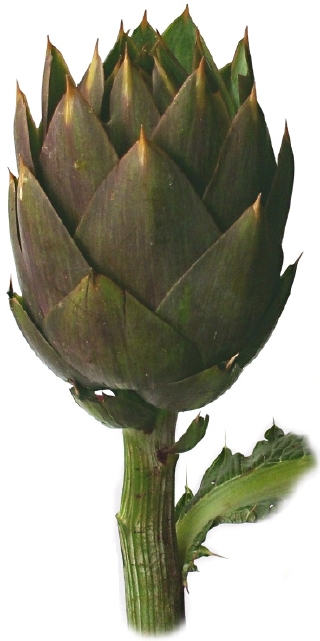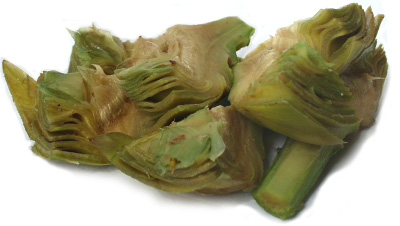...Best of Sicily presents... Best of Sicily Magazine. ... Dedicated to Sicilian art, culture, history, people, places and all things Sicilian. |
by Roberta Gangi | ||
Magazine Index Best of Sicily Arts & Culture Fashion Food & Wine History & Society About Us Travel Faqs Contact Map of Sicily |
This thistle-like perennial should not be confused with the Jerusalem artichoke, related to the sunflower. More closely related to the artichoke is its country cousin, the cardoon (cynara cardunculus), a delicacy whose comparatively slender stalks are harvest in late Autumn. Sicilians, however, make little distinction here, and sometimes consume the thicker stalks of the artichoke as though they were, in fact, cardoons. The buds of the true cardoon (known as carduna to Sicilians) are not usually eaten, while those of scolymus are consumed as artichokes. Cardoons are taller than artichoke plants, which grow closer to the ground. Some artichokes are quite large, and range in colour from deep green to yellowish or even purplish. Most domesticated varieties have no thorns. The artichoke was known in Norman Sicily and Moorish Spain, though it appears not to have been cultivated in mainland Italy during that period. This suggests an Arab origin. The Latin word is cynara, while the Italian word carciofo is a cognate of the Arabic kharshuff. In Sicily, Greek and Roman artistic representations of the purple flower suggest that the species was present centuries before the medieval Saracen conquest of the island. The literary work of Pliny and other ancient writers associated with Greece and Sicily suggest that little distinction was made between the artichoke and the cardoon, and this is consistent with modern Sicilian usage. Artichokes, which don't like too much moisture, are harvested twice annually, beginning as early as March. The Spring harvest is more substantial than the Autumn crop.
Spanish settlers introduced the artichoke to the New World as early as the seventeeth century, and Italian immigrants began the cultivation of other varieties in California during the twentieth century. To the ancient Romans, the artichoke was believed to be an aphrodisiac. Artichoke festivals are not unique to Sicily. Marilyn Monroe was once crowned "Artichoke Queen" of a Californian town. About the Author: Roberta Gangi has written numerous articles and one book dealing with Italian cultural and culinary history. | |
Top of Page |
 A
longstanding theory suggests that artichokes actually originated in
Sicily. That would be a unique distinction in a land whose culture and
cuisine is an amalgamation of foreign ones. In any event, we know that
the globe artichoke, cynara scolymus, cultivated in some fifty
varieties, evolved in the western or central Mediterranean. Artichokes
are in the asteraceae (compositae) family. Shown here, the purplish wild spiny
artichoke, featuring tough leaves ending in thorns, is the most popular
form in Sicily, where one town, Cerda (in Palermo province) has erected
a tall sculptural monument to this most singular vegetable in the main
square.
A
longstanding theory suggests that artichokes actually originated in
Sicily. That would be a unique distinction in a land whose culture and
cuisine is an amalgamation of foreign ones. In any event, we know that
the globe artichoke, cynara scolymus, cultivated in some fifty
varieties, evolved in the western or central Mediterranean. Artichokes
are in the asteraceae (compositae) family. Shown here, the purplish wild spiny
artichoke, featuring tough leaves ending in thorns, is the most popular
form in Sicily, where one town, Cerda (in Palermo province) has erected
a tall sculptural monument to this most singular vegetable in the main
square. They're not
the foundation of any diet, but artichokes are a good
source of ascorbic acid (Vitamin C), niacin, magnesium, potassium, iron,
copper, phosphorus, calcium and fiber. The substance cynarin is
thought to benefit digestion, while the juice of the leaves is used in
skin cosmetics. An artichoke liqueur bearing the trade name Cynar is
made in Sicily. Artichokes can be prepared in many ways. As well as the
heart, the soft inner leaves can be eaten if cooked well. Most of the
world's artichokes are produced in Italy, where Sardinia rivals Sicily
for quantity. Until recently, artichokes were regarded as an esoteric
specialty food by many people beyond the Mediterranean region. This is
gradually changing. With
They're not
the foundation of any diet, but artichokes are a good
source of ascorbic acid (Vitamin C), niacin, magnesium, potassium, iron,
copper, phosphorus, calcium and fiber. The substance cynarin is
thought to benefit digestion, while the juice of the leaves is used in
skin cosmetics. An artichoke liqueur bearing the trade name Cynar is
made in Sicily. Artichokes can be prepared in many ways. As well as the
heart, the soft inner leaves can be eaten if cooked well. Most of the
world's artichokes are produced in Italy, where Sardinia rivals Sicily
for quantity. Until recently, artichokes were regarded as an esoteric
specialty food by many people beyond the Mediterranean region. This is
gradually changing. With